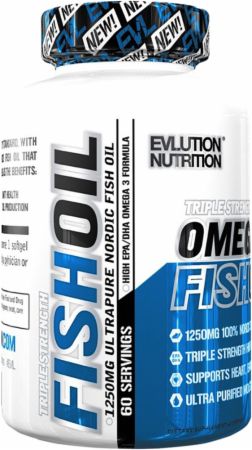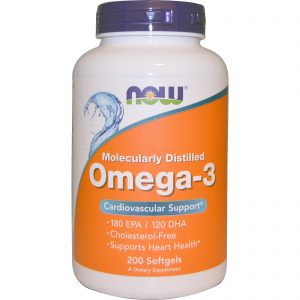Description
Omega-3 fatty acids are found in a variety of plants and animals with the highest concentration occurring in marine-based sources. EPA and DHA are found in trace amounts in beef. Grass-fed beef can have up to a 25% increase in the percentage of total polyunsaturated fatty acids compared to grain-fed beef. Additionally, a higher ratio of omega-3 to omega-6 fatty acids, including EPA and DHA, is also found in grass-fed cattle than grain-fed comparators.199 EPA and DHA can be synthesized, albeit inefficiently, from the essential omega-3 fatty acid alpha-linolenic acid (ALA). ALA cannot be synthesized by humans and must be obtained from the diet. ALA is found in flaxseed, canola, soybean, walnut, and wheat germ oils, nuts and seeds, and vegetables. Additionally, DHA can be synthesized from EPA.
Fish oils are predominantly comprised of the omega-3 fatty acids EPA and DHA; “fish oil” is a term frequently used interchangeably with, and in reference to, EPA and DHA. Marine sources containing the highest content of omega-3 fatty acids are fatty fish (eg, mackerel, halibut, salmon, bluefish, mullet, sablefish, menhaden, anchovy, herring, lake trout, coho, sardines), which provide 1 g or more of omega fatty acids per 100 g (3.5 oz) of fish. Tuna, seal, and shellfish (eg, oysters) are additional marine-based sources.
Because marine fish stocks are limited and because many fish stocks are currently contaminated by pollutants (eg, methylmercury, organochlorine pesticides), it has been proposed that the algal genes responsible for EPA and DHA production be cloned into plants.6, 7 Oils from transgenic plants would be rich in EPA and DHA, and although some success has been achieved, challenges in the biosynthetic pathways in higher plants have not yet been surmounted.8, 9
History
Most uses of fish oils have been based on the beneficial effects of EPA and DHA, specifically those related to cardiovascular, inflammatory, neural, and hormonal support. Interest in possible health benefits followed observations that populations with a high dietary intake of fish, such as Eskimo and Inuit populations, had low incidences of atherosclerotic and thrombotic disorders and inflammatory conditions.10, 11 In 1789, a publication described the beneficial effects of cod liver oil in rheumatism, and in 1824 the same oil was reported effective in the prevention of rickets.12 Historically, deficiencies were noted in infants fed non- or low-fat diets and in patients receiving long-term (eg, 2 to 3 weeks) parenteral nutritional formulations lacking polyunsaturated fatty acids.2, 3
Chemistry
EPA and DHA are omega-3, long-chain (20 carbons or more) PUFAs. EPA consists of a 20-carbon chain with 5 double bonds (20:5), while DHA is a 22-carbon chain with 6 double bonds (20:6). As represented by the omega-3 nomenclature, the first double bond is located at the third carbon from the methyl group (omega) end of the chain.2, 3 C-13 nuclear magnetic resonance pattern recognition has been used to analyze the species of fish from which commercial fish oil products are derived.13Homogenization of fish oils into milk has been explored.14 Challenges for the incorporation of fish oils into other foodstuffs include the propensity of EPA and DHA to oxidize, as well as their unpleasant tastes and smells. Thus, oil-filled capsules are the current preferred supplement product.
Uses and Pharmacology
Omega-3 fatty acids are metabolized into eicosanoids, which have important physiologic properties and include prostaglandins, prostacyclins, thromboxanes, and leukotrienes. Eicosanoids are potent regulators of blood pressure, blood clotting, childbirth, and gastric secretions, as well as immune and inflammatory responses. The actual location of the double bond in the fatty acid chain affects its metabolism such that the structure and function of omega-3–derived eicosanoids differ from those derived from omega-6 fatty acids (eg, arachidonic acid). For example, omega-3–derived eicosanoids tend to decrease blood clotting and inflammatory responses. This contrasts with the arachidonic acid (omega-6)–derived eicosanoids, which increase clotting and inflammatory responses.2, 3, 15
Omega-3 Fatty Acids
Common Name(s): Docosahexaenoic acid (DHA), Eicosapentaenoic acid (EPA), Fish Oils, LCPUFAs, Long-chain PUFAs, Lovaza, Marine oil fatty acids, Marine oils, N-3 fatty acids, Omega-3 polyunsaturated fatty acids, PUFAs
Clinical Overview
Use
Clinical benefit is strongest for lowering the risk of coronary artery disease and decreasing serum triglycerides. Reductions in the risk for all-cause mortality, cardiac death, and sudden death have been established for omega-3 fatty acid supplementation for at least 1 year’s duration. The United States Food and Drug Administration (FDA) has approved the use of fish oil for reducing very high triglyceridemia (at least 500 mg/dL [5.65 mmol/L]) in adults as an adjunct to diet. Evidence for use of parenteral fish oil lipid emulsion is mounting in severely ill and surgical patients. Evidence for a role in rheumatoid arthritis remains equivocal but promising. No consistent relationship between fish oil consumption and reduction in the risk of stroke or maintenance in inflammatory bowel disease has been established. Other areas of interest in the therapeutic use of fish oils requiring further study include asthma and allergy, dysmenorrhea, mental health, and the promotion of postnatal growth and development.
Dosing
The American Heart Association (AHA) recommends a minimum of 2 fatty fish meals per week. Clinical trials suggest fish oil supplementation of omega-3 fatty acids 1 g/day in coronary heart disease, and when triglycerides are elevated, a minimum of omega-3 fatty acids 2 g/day up to a maximum of 4 g/day. Fish oil 1,000 mg approximates to omega-3 fatty acids (eicosapentaenoic acid [EPA]/docosahexaenoic acid [DHA]) 300 to 400 mg.
Contraindications
Contraindicated in individuals with active bleeding (eg, peptic ulcer, intracranial bleeding).
Pregnancy/Lactation
Potential for mercury ingestion. Eat fish lower in mercury and avoid consumption of high-mercury containing fish, such as tilefish from the Gulf of Mexico, swordfish, king mackerel, and shark.
Interactions
The anticoagulant effect of anticoagulant medications (including warfarin), may be increased by fish oil ingestion; although, case reports are limited.
Adverse Reactions
Fish oil at dosages of EPA/DHA 2 to 5.4 g/day is well accepted and tolerated. Mild GI discomfort was reported in clinical trials.
Toxicology
Research reveals little or no information.
Source
Omega-3 fatty acids are found in a variety of plants and animals with the highest concentration occurring in marine-based sources. EPA and DHA are found in trace amounts in beef. Grass-fed beef can have up to a 25% increase in the percentage of total polyunsaturated fatty acids compared to grain-fed beef. Additionally, a higher ratio of omega-3 to omega-6 fatty acids, including EPA and DHA, is also found in grass-fed cattle than grain-fed comparators.199 EPA and DHA can be synthesized, albeit inefficiently, from the essential omega-3 fatty acid alpha-linolenic acid (ALA). ALA cannot be synthesized by humans and must be obtained from the diet. ALA is found in flaxseed, canola, soybean, walnut, and wheat germ oils, nuts and seeds, and vegetables. Additionally, DHA can be synthesized from EPA.1, 2, 3
Fish oils are predominantly comprised of the omega-3 fatty acids EPA and DHA; “fish oil” is a term frequently used interchangeably with, and in reference to, EPA and DHA. Marine sources containing the highest content of omega-3 fatty acids are fatty fish (eg, mackerel, halibut, salmon, bluefish, mullet, sablefish, menhaden, anchovy, herring, lake trout, coho, sardines), which provide 1 g or more of omega fatty acids per 100 g (3.5 oz) of fish. Tuna, seal, and shellfish (eg, oysters) are additional marine-based sources.1, 2, 3, 4, 5
Because marine fish stocks are limited and because many fish stocks are currently contaminated by pollutants (eg, methylmercury, organochlorine pesticides), it has been proposed that the algal genes responsible for EPA and DHA production be cloned into plants.6, 7 Oils from transgenic plants would be rich in EPA and DHA, and although some success has been achieved, challenges in the biosynthetic pathways in higher plants have not yet been surmounted.8, 9
History
Most uses of fish oils have been based on the beneficial effects of EPA and DHA, specifically those related to cardiovascular, inflammatory, neural, and hormonal support. Interest in possible health benefits followed observations that populations with a high dietary intake of fish, such as Eskimo and Inuit populations, had low incidences of atherosclerotic and thrombotic disorders and inflammatory conditions.10, 11 In 1789, a publication described the beneficial effects of cod liver oil in rheumatism, and in 1824 the same oil was reported effective in the prevention of rickets.12 Historically, deficiencies were noted in infants fed non- or low-fat diets and in patients receiving long-term (eg, 2 to 3 weeks) parenteral nutritional formulations lacking polyunsaturated fatty acids.2, 3
Chemistry
EPA and DHA are omega-3, long-chain (20 carbons or more) PUFAs. EPA consists of a 20-carbon chain with 5 double bonds (20:5), while DHA is a 22-carbon chain with 6 double bonds (20:6). As represented by the omega-3 nomenclature, the first double bond is located at the third carbon from the methyl group (omega) end of the chain.2, 3 C-13 nuclear magnetic resonance pattern recognition has been used to analyze the species of fish from which commercial fish oil products are derived.13Homogenization of fish oils into milk has been explored.14 Challenges for the incorporation of fish oils into other foodstuffs include the propensity of EPA and DHA to oxidize, as well as their unpleasant tastes and smells. Thus, oil-filled capsules are the current preferred supplement product.
Uses and Pharmacology
Omega-3 fatty acids are metabolized into eicosanoids, which have important physiologic properties and include prostaglandins, prostacyclins, thromboxanes, and leukotrienes. Eicosanoids are potent regulators of blood pressure, blood clotting, childbirth, and gastric secretions, as well as immune and inflammatory responses. The actual location of the double bond in the fatty acid chain affects its metabolism such that the structure and function of omega-3–derived eicosanoids differ from those derived from omega-6 fatty acids (eg, arachidonic acid). For example, omega-3–derived eicosanoids tend to decrease blood clotting and inflammatory responses. This contrasts with the arachidonic acid (omega-6)–derived eicosanoids, which increase clotting and inflammatory responses.2, 3, 15
Antiinflammatory
In a randomized, double-blind, placebo-controlled trial, 261 healthy adults received fish oil supplementation (EPA + DHA 1,400 mg) or placebo for 18 weeks to determine the effects on biomarkers of chronic, systemic inflammation. This dose of fish oil had no effect on serum c-reactive protein or IL-6 concentrations with no evidence of heterogeneity found based on gender, body mass index, baseline IL-6, or post-supplementation red blood cell EPA+DHA. Side effects associated with the intervention included fishy belch or aftertaste, loose stool, and bloating or gas pains; no serious adverse events were reported.175
Omega-3 fatty acids may be effective for managing pruritus in uremic patients according to a 2016 updated Cochrane systematic review of pharmacological interventions for pruritus in adult palliative care. An additional 10 studies with 627 participants were identified since the previous 2013 review with 1 new study that investigated omega-3 fatty acids. In this double-blind, randomized placebo-controlled crossover trial that enrolled 22 patients with end-stage renal disease, 3 g/day of omega-3s (1 g of omega-3s as EPA 180 mg and DHA 120 mg given 3 times daily) was given orally over 20 days with a 14-day washout prior to crossing over. Pruritus decreased from baseline by 65% with fish oil compared to 15% with placebo. Although the difference was statistically significant, the sample size was small and the study was of low methodological quality.189
Clinical Overview
Use
Clinical benefit is strongest for lowering the risk of coronary artery disease and decreasing serum triglycerides. Reductions in the risk for all-cause mortality, cardiac death, and sudden death have been established for omega-3 fatty acid supplementation for at least 1 year’s duration. The United States Food and Drug Administration (FDA) has approved the use of fish oil for reducing very high triglyceridemia (at least 500 mg/dL [5.65 mmol/L]) in adults as an adjunct to diet. Evidence for use of parenteral fish oil lipid emulsion is mounting in severely ill and surgical patients. Evidence for a role in rheumatoid arthritis remains equivocal but promising. No consistent relationship between fish oil consumption and reduction in the risk of stroke or maintenance in inflammatory bowel disease has been established. Other areas of interest in the therapeutic use of fish oils requiring further study include asthma and allergy, dysmenorrhea, mental health, and the promotion of postnatal growth and development.
Dosing
The American Heart Association (AHA) recommends a minimum of 2 fatty fish meals per week. Clinical trials suggest fish oil supplementation of omega-3 fatty acids 1 g/day in coronary heart disease, and when triglycerides are elevated, a minimum of omega-3 fatty acids 2 g/day up to a maximum of 4 g/day. Fish oil 1,000 mg approximates to omega-3 fatty acids (eicosapentaenoic acid [EPA]/docosahexaenoic acid [DHA]) 300 to 400 mg.
Contraindications
Contraindicated in individuals with active bleeding (eg, peptic ulcer, intracranial bleeding).
Pregnancy/Lactation
Potential for mercury ingestion. Eat fish lower in mercury and avoid consumption of high-mercury containing fish, such as tilefish from the Gulf of Mexico, swordfish, king mackerel, and shark.
Interactions
The anticoagulant effect of anticoagulant medications (including warfarin), may be increased by fish oil ingestion; although, case reports are limited.
Adverse Reactions
Fish oil at dosages of EPA/DHA 2 to 5.4 g/day is well accepted and tolerated. Mild GI discomfort was reported in clinical trials.
Toxicology
Research reveals little or no information.
| Supplement Facts | ||
| Serving Size: 2 Softgels | ||
| Servings Per Container: 100 | ||
| Amount Per Serving | %Daily Value | |
| Calories | 20 | |
| Total Fat | 2 g | 3%* |
| Saturated Fat | 0.5 g | 3%* |
| Polyunsaturated Fat | 1 g | † |
| Monounsaturated Fat | 0.5 g | † |
| Natural Fish Oil Concentrate | 2 g (2,000 mg) | † |
| Omega-3 Fatty Acids: | ||
| Eicosapentaenoic Acid (EPA) | 360 mg | † |
| Docosahexaenoic Acid (DHA) | 240 mg | † |
| *Percent Daily Values are based on a 2,000 calorie diet. †Daily Value not established. |
||




Reviews
There are no reviews yet.